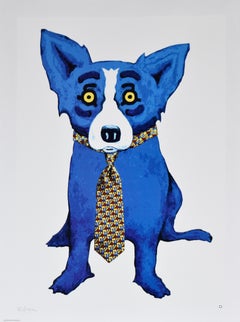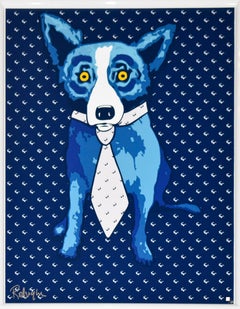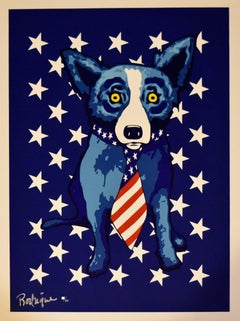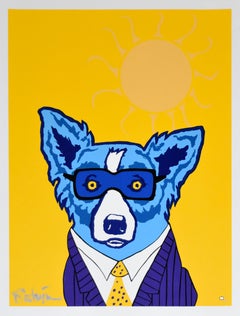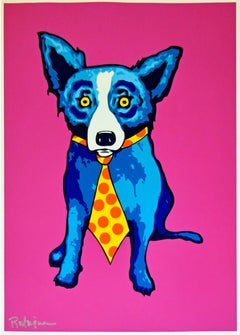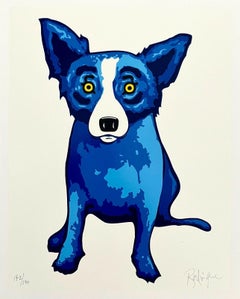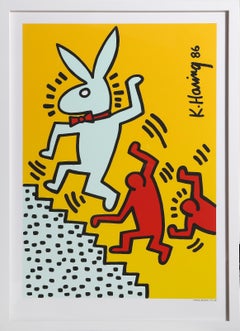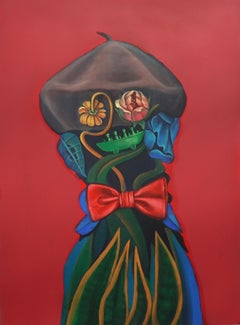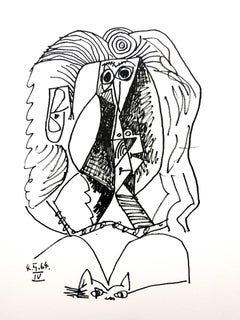Tie Animal Prints
to
1
3
1
Overall Width
to
Overall Height
to
5
5
4
1
4
5
896
2,729
1,741
1,457
1,072
834
551
491
446
444
401
349
346
329
243
233
193
182
160
142
5
5
Art Subject: Tie
Tie Me Up - White - Signed Silkscreen Blue Dog Print
Located in Mount Laurel, NJ
This Blue Dog work consists of a blue dog on a white background wearing a necktie decorated with blue dogs and alligators. The dog has soulful yellow eyes. This pop art animal original oil on canvas is hand-signed by the artist.
Artist: George Rodrigue
Title: Blue Dog “Tie...
Category
2010s Pop Art Animal Prints
Materials
Screen
Blue Dog "Shades of the 50's Blue" Print Signed Numbered Artwork
Located in Mount Laurel, NJ
This Blue Dog work consists of 1 blue dog on a dark blue background with painted white eyeglasses donning a white tie with painted blue eyeglasses. Th...
Category
1990s Pop Art Animal Prints
Materials
Screen
Star Spangled Blue Dog - Signed Silkscreen Print Blue Dog
Located in Mount Laurel, NJ
This Blue Dog work consists of the dog donning a US flag motif necktie. The dog is sitting on a blue background with white stars. The dog has soulful yellow...
Category
1990s Pop Art Animal Prints
Materials
Screen
My Future's So Bright, I Gotta Wear Shades - Signed Silkscreen Blue Dog Print
Located in Mount Laurel, NJ
This Blue Dog work consists of a blue dog on a yellow background wearing a blue striped jacket, a white shirt, and a yellow necktie with black specks. The dog is also wearing an eye...
Category
1990s Pop Art Animal Prints
Materials
Screen
Untitled Blue Dog with Tie - Magenta Background - Silkscreen Signed Print
Located in Mount Laurel, NJ
This Blue Dog work consists of a solid magenta background. There is a single dog wearing a yellow and orange polka dot tie. The dog has soulful yellow eyes. This pop art animal origi...
Category
1990s Pop Art Animal Prints
Materials
Screen
Related Items
Purity of Soul (Blue Dog Series), George Rodrigue
Located in Fairfield, CT
Artist: George Rodrigue (1944-2013)
Title: Purity of Soul (Blue Dog Series)
Year: 2005
Edition: 142/190, plus proofs
Medium: Silkscreen on archival pap...
Category
Early 2000s Pop Art Figurative Prints
Materials
Screen
$10,000 Sale Price
20% Off
H 15 in W 12 in
Bunny On The Run, Screenprint Poster by Keith Haring
By Keith Haring
Located in Long Island City, NY
Date: 1990
Screenprint Poster, signed and dated in plate, numbered in pencil
Edition of 1000
Image Size: 28 x 20 inches
Size: 32 x 23 in. (81.28 x 58.42 cm)
Commissioned by Playboy.
...
Category
1990s Pop Art Animal Prints
Materials
Screen
$925 Sale Price
21% Off
H 33.5 in W 24.75 in
L is for Leopard (small)
Located in Deddington, GB
Clare Halifax
L is for Leopard small
Limited Edition 5 Colour Silkscreen Print
Edition of 30
Image size H 22 x W 22cm
Sheet Size: H 27 x W 25cm x D 0.1cm...
Category
21st Century and Contemporary Pop Art Animal Prints
Materials
Paper, Screen
Stalking Cat, Karel Appel
By Karel Appel
Located in Fairfield, CT
Artist: Karel Appel (1921-2006)
Title: Stalking Cat
Year: 1980
Medium: Silkscreen on Arches paper
Edition: 80/125, plus proofs
Size: 24.75 x 32.25 inches
Condition: Good
Inscription:...
Category
1980s Pop Art Abstract Prints
Materials
Screen
Midnight Surprise (Blue Dog Series), George Rodrigue
Located in Fairfield, CT
Artist: George Rodrigue (1944-2013)
Title: Midnight Surprise (Blue Dog Series)
Year: 2000
Edition: 62/150, plus proofs
Medium: Silkscreen on archival paper
Size: 22 x 17.5 inches
Con...
Category
Early 2000s Pop Art Figurative Prints
Materials
Screen
$4,400 Sale Price
64% Off
H 22 in W 17.5 in
Horse and Rider, Pop Art Screenprint by Richard Hambleton
Located in Long Island City, NY
Richard Hambleton, Canadian (1952 -2017) - Horse and Rider, Year: 2001, Medium: Screenprint, signed, dated and numbered in pencil, Edition: 100, P/P, Image Size: 16 x 11 inches, ...
Category
Early 2000s Pop Art Animal Prints
Materials
Screen
$10,000
H 26.5 in W 21.5 in
Tiger-Tiger, 3-D Relief of impact-resistant polystyrene, deep-drawn, silkscreen
Located in New York, NY
Peter Phillips
Tiger-Tiger, 1968
3-D Relief made of impact-resistant polystyrene, deep-drawn, silkscreened in 8 colors, rear wall made of styrofoam and vacuum form plastic
28 7/10 × ...
Category
1960s Pop Art Animal Prints
Materials
Plastic, Polystyrene, Mixed Media, Screen
$5,500
H 28.7 in W 44.3 in D 1 in
Mod Rooster Drawing 1970s Pop Art Lithograph Hand Signed
By Bob Stanley
Located in Surfside, FL
This listing is for just the one print in the photo here. there are three states of the same image image each with Progressively increasing detail and color. the edition size is 175. Hand signed, numbered and dated. on hand made French Arches paper.
Bob (Robert) Stanley (1932-1997) was a painter, photographer and printmaker whose early work was figurative painting about contemporary American life. In the 1960s and early 1970s, he based his paintings on photographs, which he manipulated from black and white or silkscreen colored shapes. In the early 1960's, he began to base his paintings on images clipped from newspapers and magazines, following the example of Pop artists like Andy Warhol and Roy Lichtenstein, who would become his brother-in-law. Enlarged and often simplified to two vibrant saturated colors Stanley's images could be reduced to the abstract or be powerfully explicit. His preferred subjects, including rock stars, athletes and pornography, always seemed to grate against the pretenses of high art. Similar in bold use of color to Malcolm Morley. In the late 1960's Mr. Stanley started using his own photographs, basing paintings on images of tree branches or the ground, and also using pictures of life-drawing models at the School of Visual Arts.
EDUCATION
The Brooklyn Museum of Art School, Brooklyn, NY
Columbia University, New York, NY
The High Museum Art School, Atlanta, GA
Columbia University, New York, NY
Oglethorpe University, Atlanta, GA B.A. 1953
Max Beckmann Scholarship Award for Painting and Sculpture,
The Brooklyn Museum of Art School, Brooklyn, NY
TEACHING
School of Visual Arts, New York, NY, Instructor: Painting and Drawing
The New Arts Program, Kutztown, PA, Visiting Artist
Princeton University, Princeton, NJ, Visiting Artist
School of Visual Arts, New York, NY, Instructor: Painting and Drawing
SELECT INDIVIDUAL EXHIBITIONS
Figureworks, Brooklyn, NY, Celebrating the Erotic Work of Pop-Artist Bob Stanley
The Mayor Gallery, London, England, “Bob Stanley – Works from the Sixties”
Beatrice Conde Gallery, New York, NY, Late Paintings
Mitchell Algus Gallery, New York, NY, Paintings: 1963-1967
Gallerie Georges Lavrov, (Paris), Die International Kunstmesse, Art Basel, Switzerland
Galerie Georges Lavrov, Paris, France, Catalog text by Richard Artschwager
The Paul Bianchini Gallery, New York, NY
Galerie Ricke, Kassel, Germany
Bianchini-Birillo Gallery, New York, NY
SELECTED GROUP EXHIBITIONS
Mitchell Algus Gallery, New York, NY, Exquisite Corpe – Cadavre Exquis
Karolyn Sherwood Gallery, “Up Close and Personal: A Collection of Minimalist and Figurative Drawings”
Steven Vail Gallery, “Paintings and Drawings” 2 person exhibition with Jan Frank...
Category
1970s Pop Art Animal Prints
Materials
Lithograph, Screen
Clare Halifax, J is for (Blue) Jay, Limited Edition Print, Bird Art
Located in Deddington, GB
Clare Halifax
J is for (Blue) Jay
Limited Edition 3 Colour Silkscreen Print
Edition of 75
Image size H 22 x W 22cm
Sheet Size: H 27 x W 25cm x D 0.1cm
Sold Unframed
Please note that ...
Category
2010s Pop Art Animal Prints
Materials
Paper, Screen
$54
H 10.63 in W 9.85 in D 0.04 in
Kenny Scharf, silkscreen on Fabriano paper Rare signed Printers Proof Rainforest
By Kenny Scharf
Located in New York, NY
Kenny Scharf
Untitled from the environmental portfolio "Columbus: In Search of a New Tomorrow", 1992
Color silkscreen on Fabriano paper with blind stamp, held in the original portfol...
Category
1990s Pop Art Abstract Prints
Materials
Screen
Mod Rooster Drawing 1970s Pop Art Lithograph Hand Signed
By Bob Stanley
Located in Surfside, FL
This listing is for just the one print in the photo here. there are three states of the same image image each with Progressively increasing detail and color. the edition size is 175. Hand signed, numbered and dated. on hand made French Arches paper.
Bob (Robert) Stanley (1932-1997) was a painter, photographer and printmaker whose early work was figurative painting about contemporary American life. In the 1960s and early 1970s, he based his paintings on photographs, which he manipulated from black and white or silkscreen colored shapes. In the early 1960's, he began to base his paintings on images clipped from newspapers and magazines, following the example of Pop artists like Andy Warhol and Roy Lichtenstein, who would become his brother-in-law. Enlarged and often simplified to two vibrant saturated colors Stanley's images could be reduced to the abstract or be powerfully explicit. His preferred subjects, including rock stars, athletes and pornography, always seemed to grate against the pretenses of high art. Similar in bold use of color to Malcolm Morley. In the late 1960's Mr. Stanley started using his own photographs, basing paintings on images of tree branches or the ground, and also using pictures of life-drawing models at the School of Visual Arts.
EDUCATION
The Brooklyn Museum of Art School, Brooklyn, NY
Columbia University, New York, NY
The High Museum Art School, Atlanta, GA
Columbia University, New York, NY
Oglethorpe University, Atlanta, GA B.A. 1953
Max Beckmann Scholarship Award for Painting and Sculpture,
The Brooklyn Museum of Art School, Brooklyn, NY
TEACHING
School of Visual Arts, New York, NY, Instructor: Painting and Drawing
The New Arts Program, Kutztown, PA, Visiting Artist
Princeton University, Princeton, NJ, Visiting Artist
School of Visual Arts, New York, NY, Instructor: Painting and Drawing
SELECT INDIVIDUAL EXHIBITIONS
Figureworks, Brooklyn, NY, Celebrating the Erotic Work of Pop-Artist Bob Stanley
The Mayor Gallery, London, England, “Bob Stanley – Works from the Sixties”
Beatrice Conde Gallery, New York, NY, Late Paintings
Mitchell Algus Gallery, New York, NY, Paintings: 1963-1967
Gallerie Georges Lavrov, (Paris), Die International Kunstmesse, Art Basel, Switzerland
Galerie Georges Lavrov, Paris, France, Catalog text by Richard Artschwager
The Paul Bianchini Gallery, New York, NY
Galerie Ricke, Kassel, Germany
Bianchini-Birillo Gallery, New York, NY
SELECTED GROUP EXHIBITIONS
Mitchell Algus Gallery, New York, NY, Exquisite Corpe – Cadavre Exquis
Karolyn Sherwood Gallery, “Up Close and Personal: A Collection of Minimalist and Figurative Drawings”
Steven Vail Gallery, “Paintings and Drawings” 2 person exhibition with Jan Frank
Newhouse Center for Contemporary Art, Snug Harbor Cultural Center, SI, NY, “The Figure: Another Side of Modernism”
Contemporary Arts Center, Cincinnati, OH, travels to 10 other institutions; “It’s Only Rock
and Roll”, Catalog essay by David S. Rubin, Curator of 20th Century Art, Phoenix Art Museum
Beatrice Conde Gallery, New York, NY, “Paintings, Drawings, Photographs”
The Painted Bride Art Center, Philadelphia, PA, 2 person exhibition with Patricia McCabe
Centro Cultural La General, Granada, Spain, “Honenaje a Federico García Lorca
White Columns, New York, NY, “Overtalk: Bob Stanley, Öyvind Fahlström, Peter Nagy
Lyman Allyn Museum, New London, CT, “The Pop Decade: The Bianchini Gallery
in the Sixties”; Exhibition monograph by Barbara Zabel
Fuji Television Gallery, Tokyo, Japan, “Contemporary Graphics: NYC”
The Art Museum, Princeton University, Princeton, NJ, “A Decade of Visual Arts at
Princeton: Faculty 1975-1985”’ Catalog text by Allen Rosenbaum and James Seawright
Centro Studi Pietro Mancini, Cosenza, Italy, “Progetto su Pace, Guerra e Altro”
The Fort Worth Art Museum, Fort Worth, TX, “The Pop Art Print”
The Madison Art Center, Madison, Wisconsin, “Recent Acquisitions”
Harcus Gallery, Boston, MA, “Artist/Poet’s Books”
The American Academy and Institute of Arts and Letters New York, NY, “Paintings
and Sculpture: 1982 Art...
Category
1970s Pop Art Animal Prints
Materials
Lithograph, Screen
Blue Skies Shinning on Me (Blue Dog Series), George Rodrigue
Located in Fairfield, CT
Artist: George Rodrigue (1944-2013)
Title: Blue Skies Shinning on Me (Blue Dog Series)
Year: 2005
Edition: 141/190, plus proofs
Medium: Silkscreen on a...
Category
Early 2000s Pop Art Figurative Prints
Materials
Screen
$10,000 Sale Price
20% Off
H 15 in W 12 in
Previously Available Items
Vibrant Original Limited Editrion Print on Dibond 25/25. Luckily Alive
Located in FISTERRA, ES
Part of Lelenco's acclaimed "Fetiches" series, this limited edition high-quality Dibond direct UV print captures the fusion of portraiture and floral elements that defines her work. ...
Category
2010s Surrealist Portrait Prints
Materials
Metal
H 15.75 in W 11.82 in D 0.2 in
Le Goût de Bonheur: one plate (portrait)
Located in Collonge Bellerive, Geneve, CH
Artist: Pablo Picasso (after)
Medium: lithograph, Arches paper
Portfolio: Le Goût de Bonheur
Year: 1970
Edition: Total of 1998 copies (666 each in G...
Category
1960s Modern Animal Prints
Materials
Lithograph
